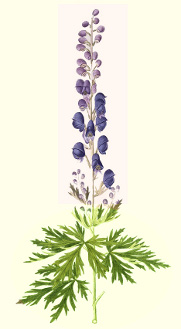 Aconitum napellus Aconitum napellusMonkshood One of the baneful herbs, monkshood was a component in flying ointments of the Middle Ages and is used to consecrate magickal blades. This deadly poisonous Saturn plant is sacred to Hekate, who created it from the foam of the mouth of Cerberus, the three-headed dog who guarded the gates of the Underworld. It can be used ritually for investigating that realm and so is a fine addition to any witch's garden, but it demands great caution in terms of both its poisonousness and its spiritual power, which is generally far beyond human capabilities. It is also dedicated to love, showing the dark side of Venus. This is a classic magick herb for the witch's garden, and it is inspirational to grow a single example of this plant tribe to represent the old gods and simply be tended as a way of reverencing them. This native of the European mountains has a flower constructed especially to attract bumble bees, with a perfect landing platform. In this way it demonstrates its Martial aspect, and in some cultures, the hoods are seen as soldiers' helmets. Effective war magic can be made by spilling one's own blood on the plant's bed. This is one plant that it is best never to touch. In Flying Ointments Back in the Middle Ages, this baneful herb was often on lists of ingredients of flying ointments. These ingredients might have been selected to balance out each other's poisonousness. At least one modern-day author has argued that because atropine, an alkaloid in belladonna, is an antidote to aconitine, the primary poisonous alkaloid in monkshood, that these ointments would not have been lethal. But we have no way of knowing whether the recipes that have come down to us are correct and whether they list all the herbs needed to detoxify the poisonous ones. After all, they were generally written down by people who not only did not practice witchcraft but got the information through hearsay at best. And given the usual low level of scholarship in herb lore (and in magick, for that matter), we sure wouldn't be willing to bet my life on it. Toxicity Although monkshood is a part of many medicinal systems, it is a deadly poison that paralyses. It has been applied externally to kill joint pain and against fever, and it is still an important remedy in homeopathy, where doses are so small that they are measured in terms of vibration rather than actual presence of molecules. The roots are most powerful in the autumn, after the upper part of the plant has died. Also known as aconite, bear's foot, blessed lady's gloves, blue rocket, friar's cap, granny jump out o'bed, granny's nightcap, queen's fettle, priest's cap, soldier's cap, Turks' cap, and auld wife's huid. Top How to grow monkshood from seed These seeds are difficult to germinate. Use the baggie method: Wet and wring out a paper towel (a weak solution of water and liquid kelp can help germinaton). Sprinkle the seeds on half or a quarter of the paper towel. Fold up the towel and gently press the layers together. Put it into a baggie. The cheap, thin baggies work best. You want a little oxygen to get through. Don't seal it. Just fold it closed. Don't forget to label with the name of the seed and the date you started them. Keep the baggie at room temperature and no direct light for 4 weeks. Make sure the paper towel stays moist but not wet and watch it doesn't start to mold in there. Then close the bag and put in the freezer for six weeks. Take out and sow in sterile planting soil (Jiffy-7 pellets work) and move to temps in the 40-50F/4-10C outside (not in sun) for germination. Or sow outside in pots on Winter Solstice (see the Solstice Sowing page) and put pots on the north side of the house (aconies like it COLD). Be very careful when handling the seeds if they are wet; the poisonous alkaloid can be absorbed through your skin, and the seeds are high in it because it is a protective to the plant, so if the seeds are wet, plant with latex gloves on or at least immediately wash with soap and water afterwards. Don't ever touch the sap of this plant. This perennial gets 3-5.5 feet/150 cm tall and is hardy in zone 4-9, the temperate area and somewhat north. It likes light shade and somewhat moist, rich soil, as would be found in the forest. It takes 2 years to flower, but you can propagate this plant by root division once you get it going. Don't grow with food plants or with herbs used in food. You don't want to accidentally harvest and eat this plant. Nevertheless, lots of people grow it with absolute safety, and the flower spike makes a nice dried flower. Add plenty of composed cow manure (Black Cow) to the soil where you transplant them out. This is a deer-proof plant, but some moths enjoy eating it as caterpillers. General growing info. Top |
Aconitum napellus
Uses in
Witchcraft & Magic:
Witch's Garden Herb © 2004-2024 Alchemy Works; No reproduction without permission. |
Alchemy Works products are offered for use in spiritual, ritual, meditative, and magical practices, not for medicinal or cosmetic purposes. The information on this website is provided for its folkloric, historic, and magical value. It is not intended to be a substitute for professional medical advice, diagnosis, or treatment.